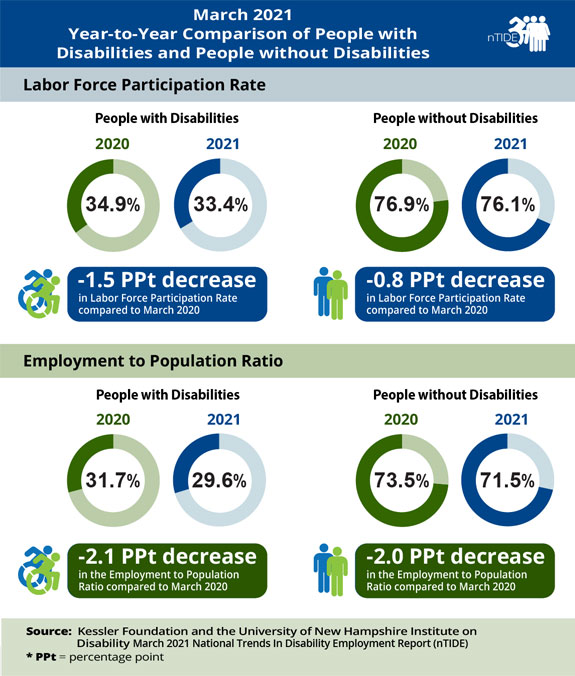nTIDE March 2021 Jobs Report: Job numbers flatten as economic recovery pauses


National Trends in Disability Employment (nTIDE) – issued semi-monthly by Kessler Foundation and the University of New Hampshire
East Hanover, NJ – April 2, 2021 – The job numbers flattened for people with and without disabilities, reflecting a pause in the economic recovery from the impact of the COVID-19 pandemic, according to today’s National Trends in Disability Employment – Monthly Update (nTIDE), issued by Kessler Foundation and the University of New Hampshire’s Institute on Disability (UNH-IOD). The direction of future trends will be affected by the course of the pandemic, the success of the vaccine rollout, and the effects of federal stimulus money.
nTIDE COVID Update (month-to-month comparison)
In the Bureau of Labor Statistics (BLS) Jobs Report released Friday, the employment-to-population ratio for working-age people with disabilities increased from 28.8 percent in February to 29.6 percent in March (up 2.8 percent or 0.8 percentage points). For working-age people without disabilities, the employment-to-population ratio also increased from 71.1 percent in February to 71.5 percent in March (up 0.6 percent or 0.4 percentage points). The employment-to-population ratio, a key indicator, reflects the percentage of people who are working relative to the total population (the number of people working divided by the number of people in the total population multiplied by 100).
“Consistent with last month’s nTIDE report, we saw minimal change in the employment-to-population ratio for those with and without disabilities,” said John O’Neill, PhD, director of the Center for Employment and Disability Research at Kessler Foundation. “We should see improvement as larger proportions of the working-age population are vaccinated and the risk of COVID-19 infection is substantially reduced,” he added.
The labor force participation rate for working-age people with disabilities remained the same, 33.4 percent in February and March (0 percent change or 0 percentage points change). For working-age people without disabilities, the labor force participation rate was virtually unchanged, increasing from 76.0 percent in February to 76.1 percent in March (up 0.1 percent or 0.1 percentage points). The labor force participation rate is the percentage of the population that is working, not working and on temporary layoff, or not working and actively looking for work.
“Over the course of the pandemic, people with disabilities have largely remained engaged in the labor force,” noted economist Andrew Houtenville, PhD, research director of the University of New Hampshire’s Institute on Disability, “so a lack of decline in the labor force participation rate since February is not entirely surprising. It is, however, a bit surprising to see little movement the rate for people without disabilities. Their labor force participation has yet to recover from the national lockdown in April 2020.”
Traditional nTIDE Numbers (comparison to the same time last year)
The employment-to-population ratio for working-aged people with disabilities decreased from 31.7 percent in March 2020 to 29.6 percent in March 2021 (down 6.6 percent or 2.1 percentage points). For working-age people without disabilities, the employment-to-population ratio also decreased from 73.5 percent in March 2020 to 71.5 percent in March 2021 (down 2.7 percent or 2 percentage points).
The labor force participation rate for working-age people with disabilities decreased from 34.9 percent in March 2020 to 33.4 percent in March 2021 (down 4.3 percent or 1.5 percentage points). For working-age people without disabilities, the labor force participation rate also decreased from 76.9 percent in March 2020 to 76.1 percent in March 2021 (down 1.0 percent or 0.8 percentage points).
In March 2021, among workers ages 16-64, the 4,440,000 workers with disabilities represented 3.2 percent of the total 140,573,000 workers in the U.S.
nTIDE COVID Update – Friday, April 23 at 12:00 pm Eastern
Stay tuned for our mid-month update about the employment of people with disabilities as we follow the impact of COVID-19 and look at the numbers in more detail.
Ask Questions about Disability and Employment
Join our nTIDE Lunch & Learn series today, April 2, at 12:00 pm Eastern. This live broadcast, hosted via Zoom Webinar, offers attendees Q&A on the latest nTIDE findings, provides news and updates from the field, as well as invited panelists to discuss current disability-related findings and events. Today, Lamondre Pough, PhD, Chief Sustainability Officer at Ruh Global IMPACT, joins Drs. Houtenville and O’Neill, and Denise Rozell, Policy Strategist at AUCD. Join live or watch the recordings at: ResearchonDisability.org/nTIDE.
NOTE: The statistics in the nTIDE are based on Bureau of Labor Statistics numbers but are not identical. They are customized by UNH to combine the statistics for men and women of working age (16 to 64). nTIDE is funded, in part, by grants from the National Institute on Disability, Independent Living and Rehabilitation Research (NIDILRR) (90RT5037) and Kessler Foundation.
About Kessler Foundation
Kessler Foundation, a major nonprofit organization in the field of disability, is a global leader in rehabilitation research that seeks to improve cognition, mobility, and long-term outcomes -- including employment -- for people with neurological disabilities caused by diseases and injuries of the brain and spinal cord. Kessler Foundation leads the nation in funding innovative programs that expand opportunities for employment for people with disabilities. For more information, visit KesslerFoundation.org.
About the Institute on Disability at the University of New Hampshire
The Institute on Disability (IOD) at the University of New Hampshire (UNH) was established in 1987 to provide a coherent university-based focus for the improvement of knowledge, policies, and practices related to the lives of persons with disabilities and their families. For information on the NIDILRR-funded Employment Policy and Measurement Rehabilitation Research and Training Center, visit ResearchonDisability.org.